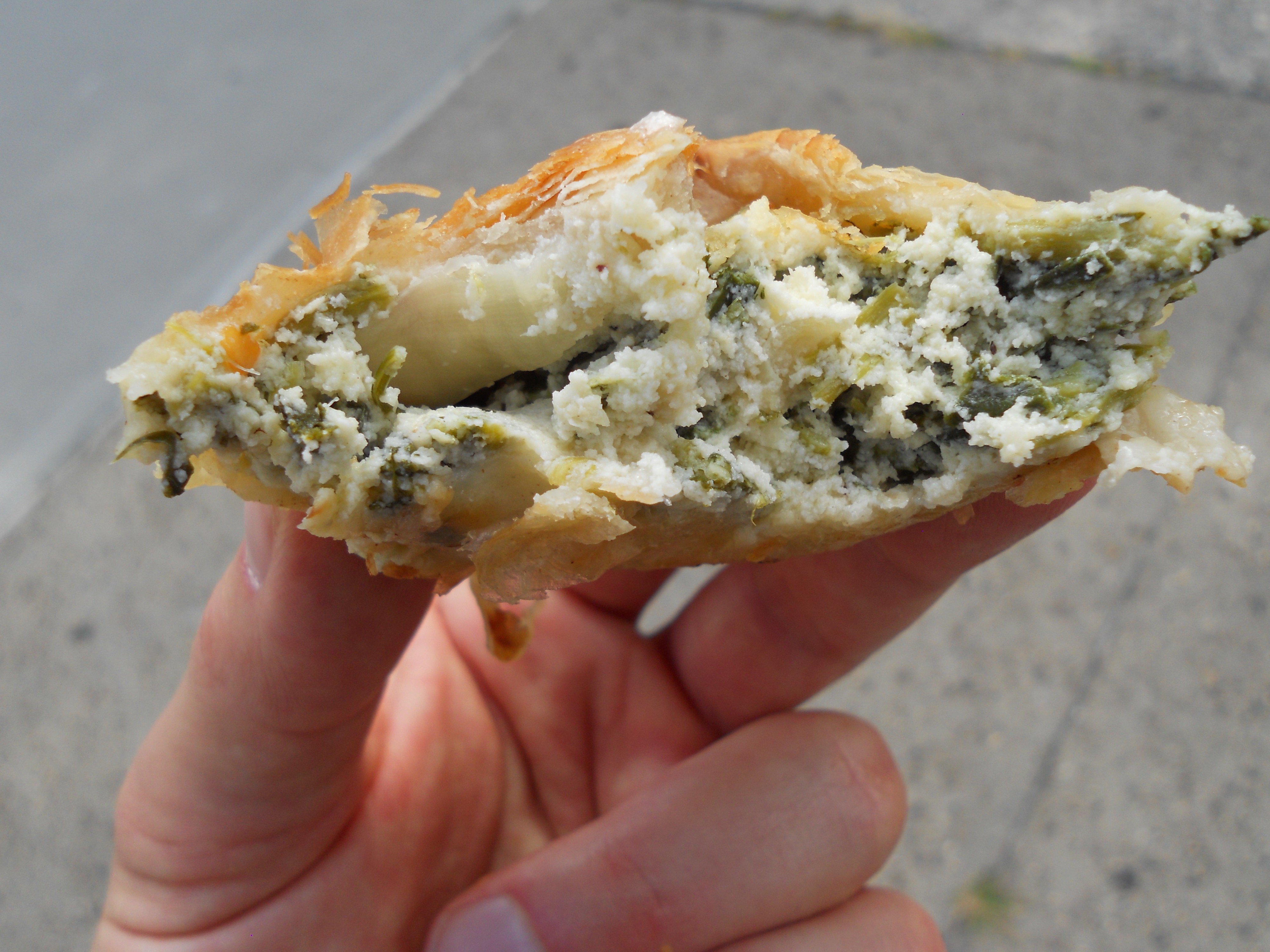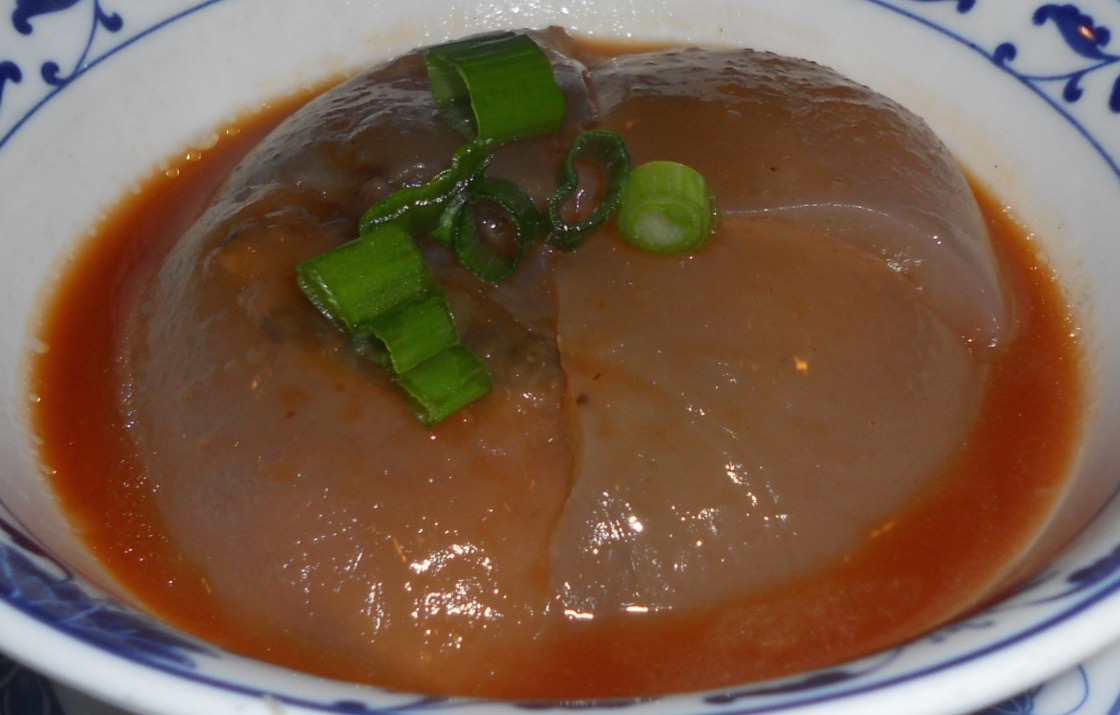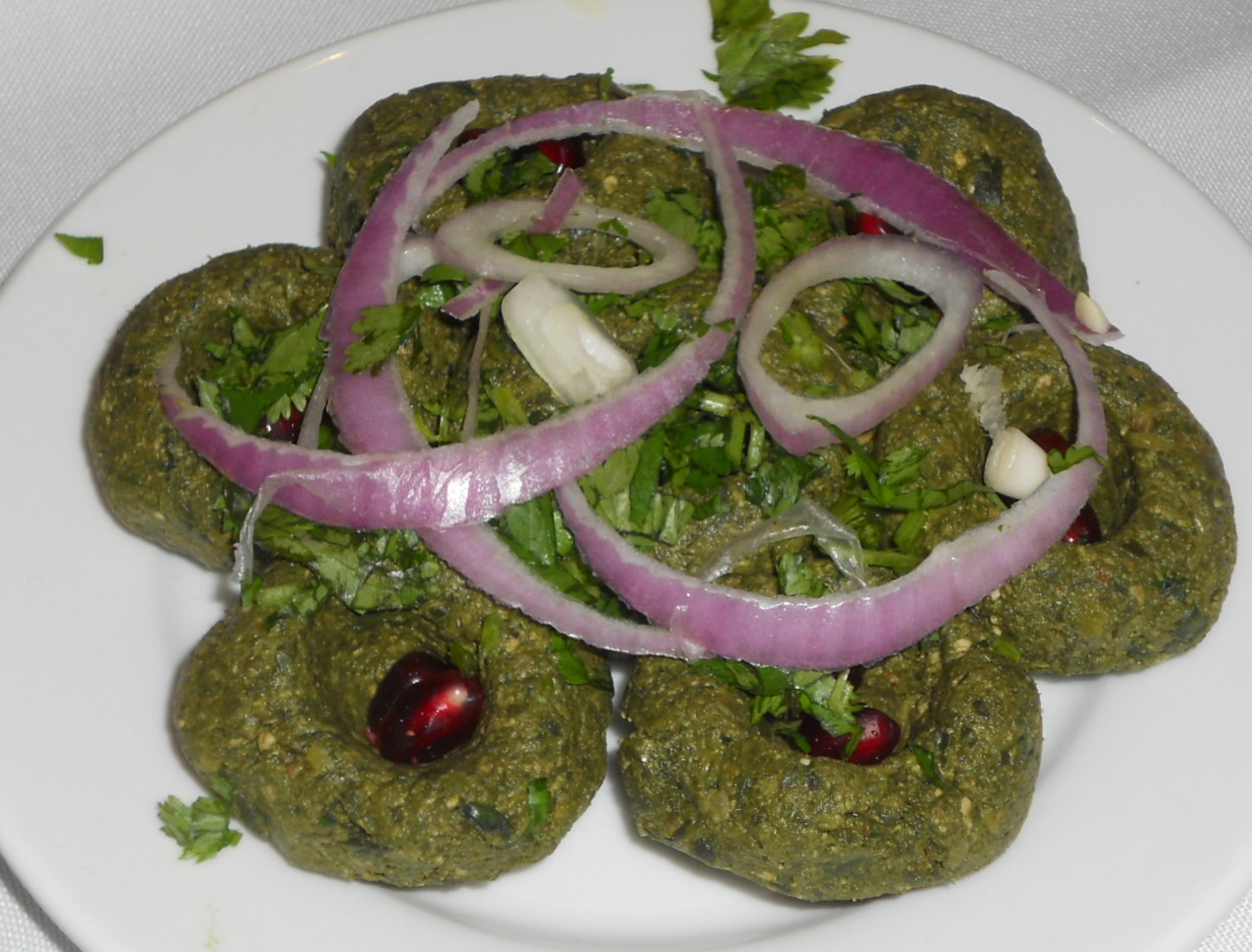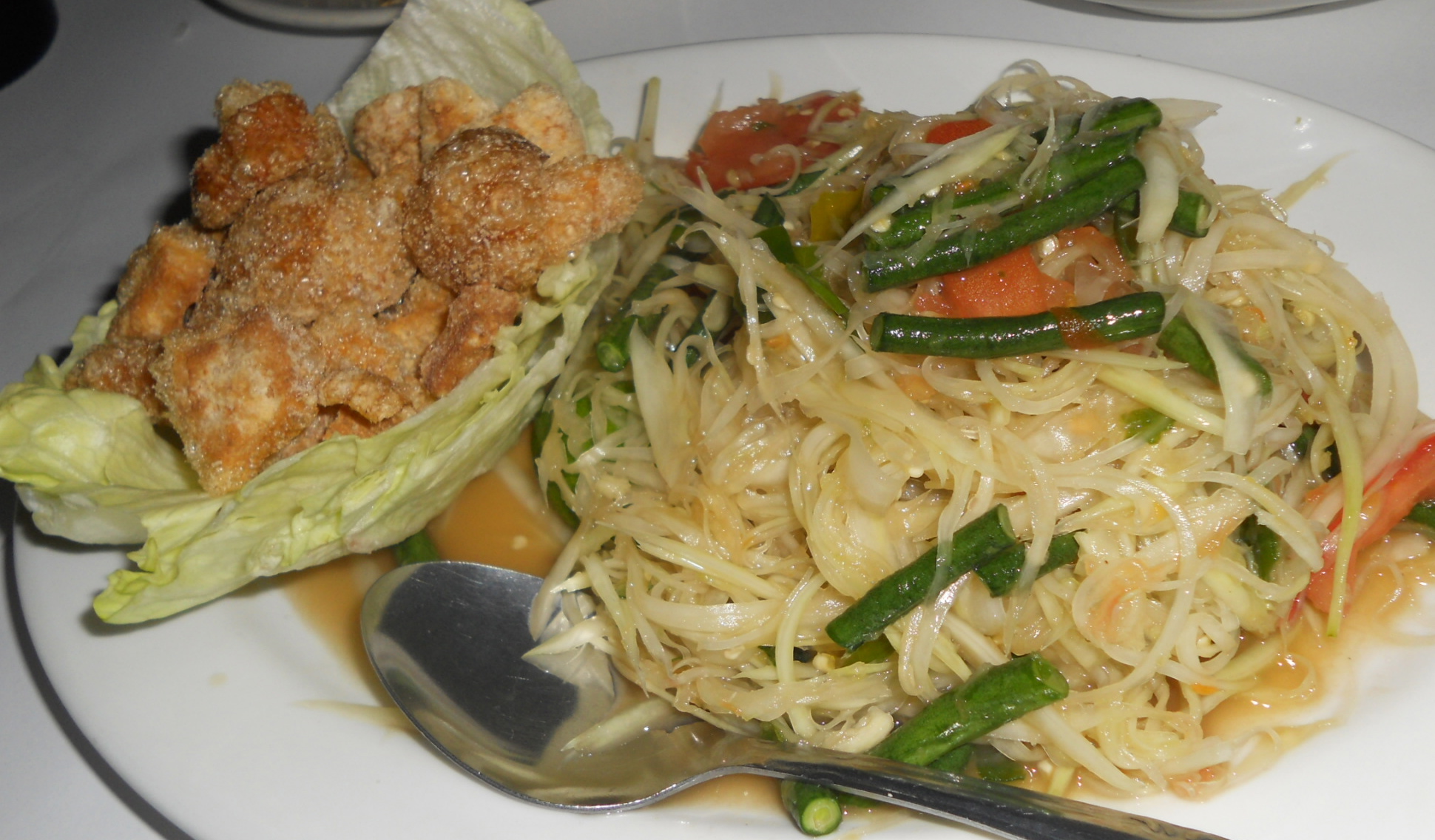|
|
Of the 27 remaining hard-to-find cuisines, there are two that stick out like sore thumbs. Why haven’t I found Costa Rican or Nicaraguan food in New York City?!?! I have no idea. There’s a nice supply of Costa Rican restaurants in Connecticut and New Jersey, but none in New York. There’s even a Costa Rican eatery in Ridgway, Colorado, which has a population of 932.
But in New York? Nope, until… well, about three weeks ago.
If you gaze deeply into the Ticos en New York Facebook page, you might be lucky enough to find a hidden gem: there’s a brand-spanking-new Costa Rican place in Richmond Hill, Queens called Punto Sabroso. Well, sort of: thanks to the quirks of New York City’s business licensing laws, the restaurant is temporarily stuck with the establishment’s previous name, E & S Jugos. And as the name suggests, the place does serve fresh-squeezed juice, but it also doubles as New York’s only Tico restaurant.
Punto Sabroso owner Katrasha Her – a friendly, lovable Honduran chef who spent six years working in a Costa Rican restaurant in Connecticut – somehow squeezes some wonderful dishes out of her pint-sized kitchen, using a scrappy arsenal of plug-in hot plates and countertop appliances. The place is small – our gang of three occupied nearly every seat in the restaurant – but mighty.
You can never go wrong with a good stewed chicken, and Katrasha nailed it: it was fall-off-the-bone tender, in a refreshing sauce of onions, peppers, and tomatoes, served with corn tortillas, a small salad, white rice, and gallo pinto, Costa Rica’s beloved mixture of rice and beans:
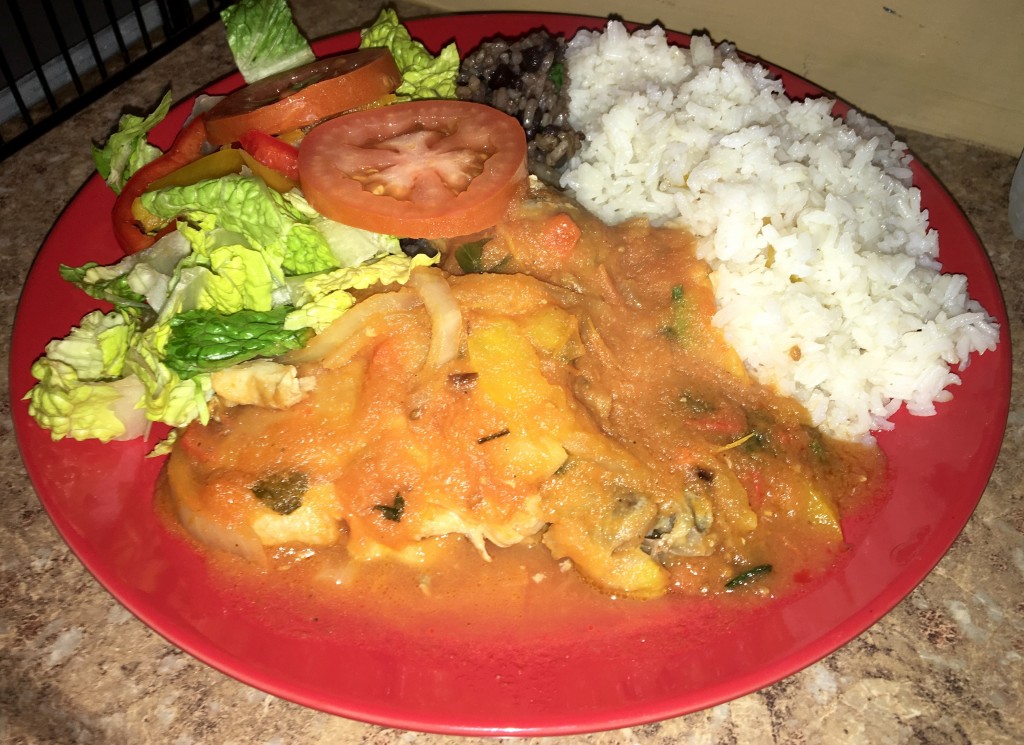 delicious national obsession, with salad, rice, and stewed chicken
One of my companions ordered a perfectly cooked pork chop, served with the same array of sides, including more gallo pinto. I was an even bigger fan of the medallions of stewed beef tongue, slow-cooked in tomatoes, onions, and peppers until the beef had a silky consistency. I honestly don’t understand why beef tongue isn’t more popular in the United States: for my taste, it easily beats any expensive steak when it’s prepared well. The dish was again served with corn tortillas, salad, white rice, and gallo pinto:
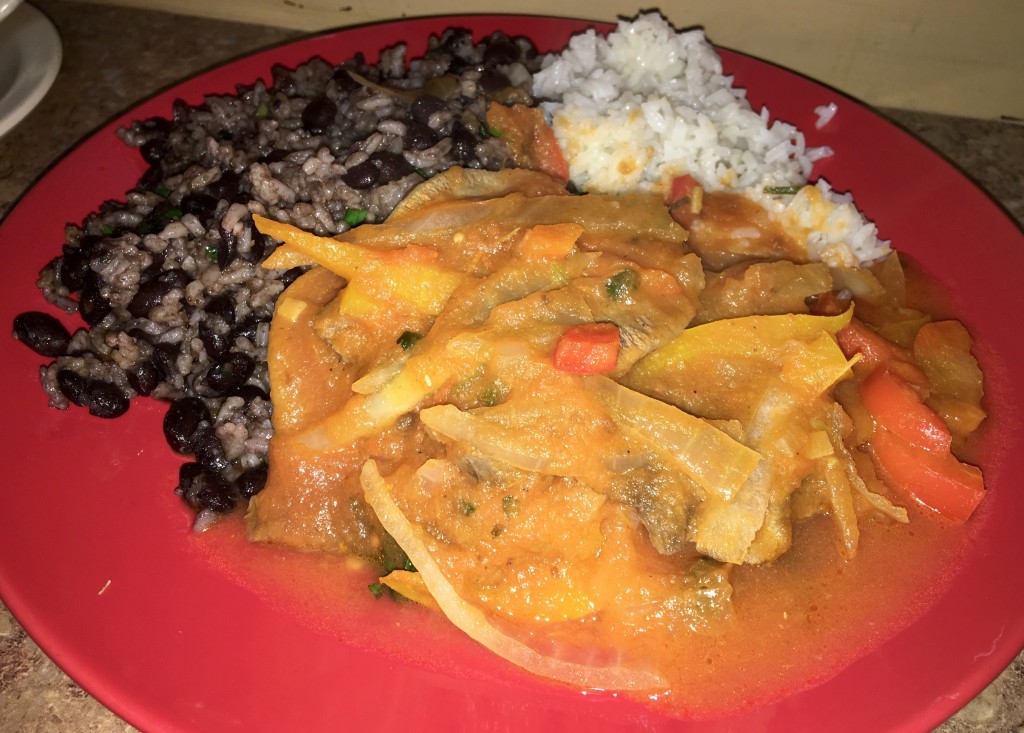 no need for the filet mignon — just slip me some beef tongue
I’m told that gallo pinto is a national obsession in Costa Rica, almost as beloved as the national fútbol team. If you’ve ever been to Honduras, you might have enjoyed a similar mash of rice and beans, called casamiento. Katrasha – who is an excellent conversationalist, and wonderfully patient with my Tarzan Spanish – generously revealed the secret ingredient that distinguishes Costa Rican gallo pinto from the casamiento made in her native Honduras: Salsa Lizano, a vegetable-based sauce that gives gallo pinto its characteristic hint of sweetness.
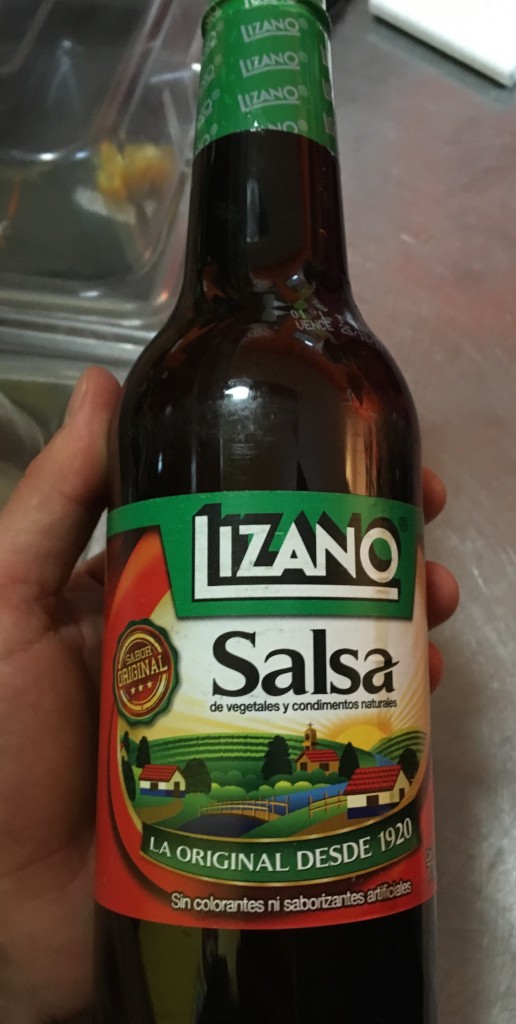 shhhhhh…
So now you know the secret to good gallo pinto, as explained by a friendly Honduran. I can’t, however, tell you anything about the secrets behind our delicious dessert of chorreadas – thin, crepe-like pancakes made from corn and a nice dash of cinnamon:
 mmm… corn
If I have a complaint about the restaurant, it’s the fact that it’s small, and I can’t bring everybody I know all at once: the three of us happily occupied most of the restaurant’s seats, but the space is designed for takeout, not lingering diners. But there’s really, really good news on the horizon: Katrasha is working on expanding into a much larger restaurant, prodded by New York City Ticos who want a gathering spot to drink Imperial, eat gallo pinto, and watch their beloved national team. Stay tuned.
Punto Sabroso / E & S Jugos
86-21 115th Street, Jamaica
Subway: 110 Street (J train)
In case you’re wondering: since Chef Katrasha is not actually Costa Rican, this meal doesn’t “count” as part of my project — even if it’s delicious and features an appropriate dose of Lizano. But if you know any Costa Ricans who might be willing to prepare a simple Tico dish, please contact me at [email protected], or find me on Twitter or Facebook.
|
|
|
To be honest, I don’t know how the heck I’m going to find food from these last few countries. I was just telling a friend that there’s no way that I’ll ever cross another country off my list by eating in a restaurant again – from here, it’s all about asking friendly people to cook for me. I mean, it’s not like there’s a Togolese restaurant in the Bronx or anything…
Oh, wait. Yeah, there is. Thanks to the great Jared Cohee from Eat the World NYC, I learned that I had my head wedged firmly up my ass: Bognan International Corporation in the Bronx is owned by a lively Togolese family who knows how to put their heart into an epic plate of food.
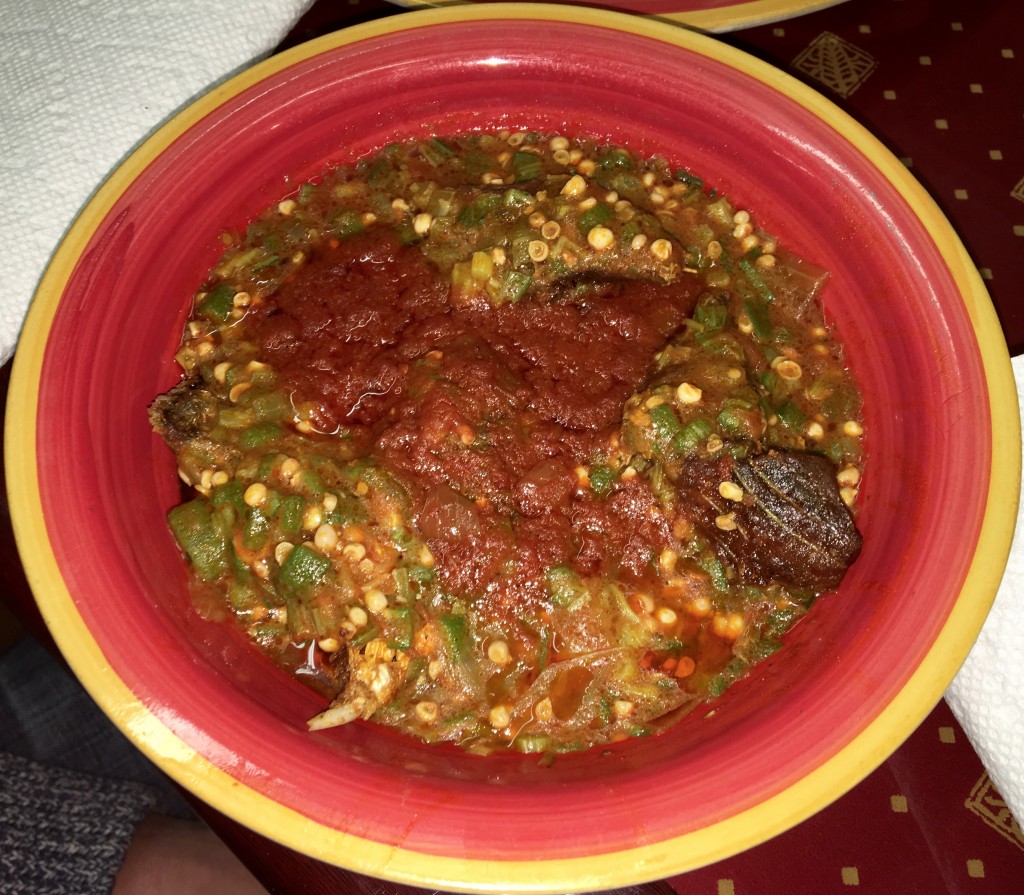 Um… am I hallucinating, or is that a chile-oil heart floating on my okra?
So I was in the neighborhood (Morrisania, in the heart of the Bronx) last week, chasing three (completely false) rumors of Gambian food nearby. I dropped by just to check Bognan’s hours, knowing that I’d be back for a meal a few days later. Bognan co-owner Fousseni Alidou – also known as “Ali” – introduced himself, and as I was leaving, he pressed two chunks of pan-fried chicken into my hands as a parting gift.
Dude loves feeding people. I trusted him immediately.
 even German guys with microphones trust him
So when we appeared a few nights later for dinner, we put ourselves completely at the mercy of our Togolese hosts. We asked Ali and his team to make whatever they felt like making, as long as there were meals for our vegetarian and pescatarian (um, that’s a word, right?) companions, and something meaty for the rest of us.
Ali proceeded to absolutely bury the six of us – including a German public radio reporter, a Dominican-American student who wrote this article about the NYC Togolese community, and the founder of the Queens Night Market – in a mountain of food. For our vegetarian friend, he offered a bowl of stewed okra, topped with chile oil; the pescatarian received okra stewed with fish. Both dishes were served with a cornucopia of starches: white rice, fried plantains, some lovably thick spaghetti, and plenty of fufu – dense balls of pounded cassava that our German friend initially mistook for mashed potatoes.
If you’re the sort of person who eats like a hippo, Bognan is pretty much heaven: neither the vegetarian nor the pescatarian managed to even make a dent in their meals. And their plates were downright runty compared to the mounds of goat and bird the rest of us ate.
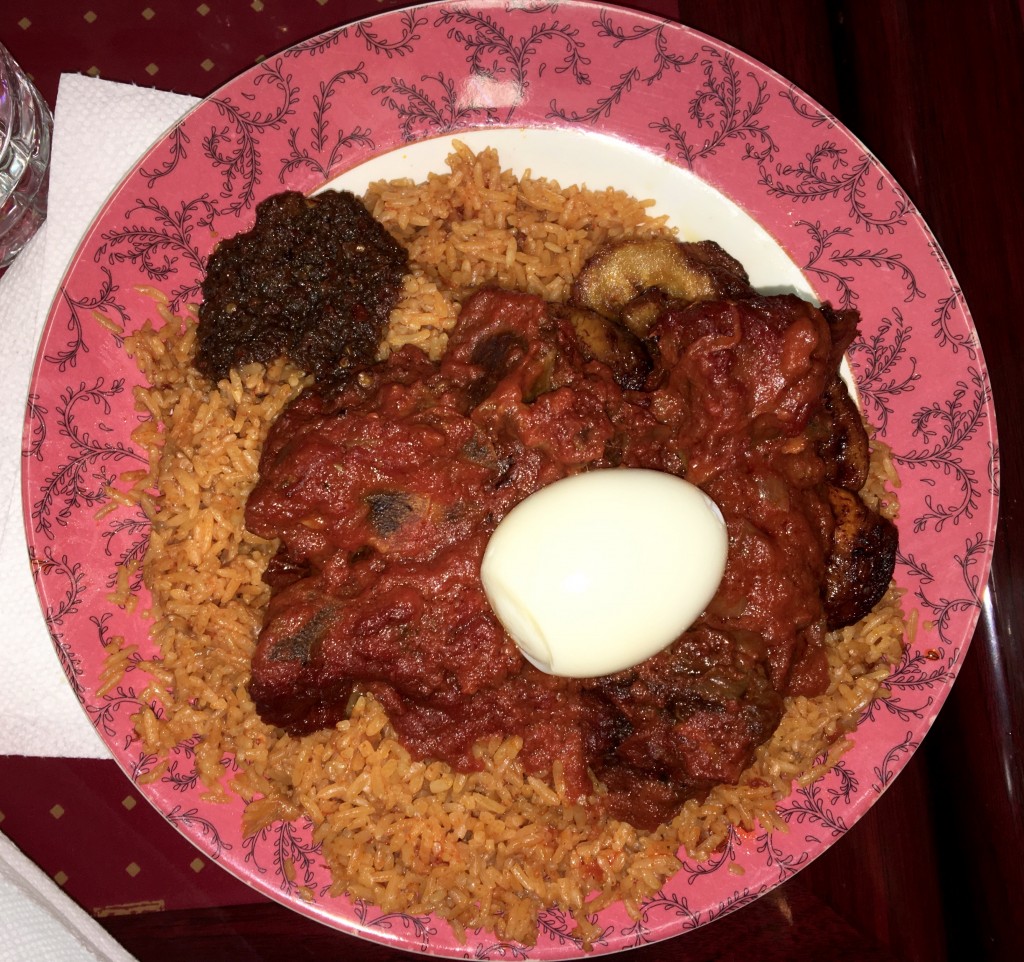 not runty
For two of us, our mountain of chow featured goat in a phenomenal tomato sauce, served atop an enormous bowl of joloff rice, along with a dark, delicious chili paste, a boiled egg, and a few fried plantains. A third friend received a gigantic bowl of chicken stewed in a tomato sauce, atop a dense mix of rice and black-eyed peas, accompanied by more pasta, more plantains, another boiled egg, and more of the dark chile paste. And meat-eater #4 received goat in a delightful peanut sauce, seasoned with a rivulet of chile oil.
You know, it would be easy enough to mistake Ali’s meals for generic West African fare: okra, tomato sauce, and peanut sauce are all standard in West African restaurants. But I have to give Ali his props: I rarely meet a plate of West African food I don’t love, but this stuff was even more flavorful than most, spiked with an extra bit of chile paste and curry and anise, among other spices. Plus, I love slime. No really: I freaking love some nice, slimy okra, especially when it has a kick to it.
You know what else I love? Watching my friends leave me as many leftovers as I can handle. One of my five companions ate about half of her entrée; the others didn’t even make it to the halfway mark before they surrendered to the hugeness of Ali’s plates. I liked my accidental buffet.
And in case you’re wondering, “Bognan” apparently means “one who is always there for others.” So you wanna be stuffed like a monstrous, happy teddy bear with a blissful food coma? True to his restaurant’s name, our man Ali is there for you.
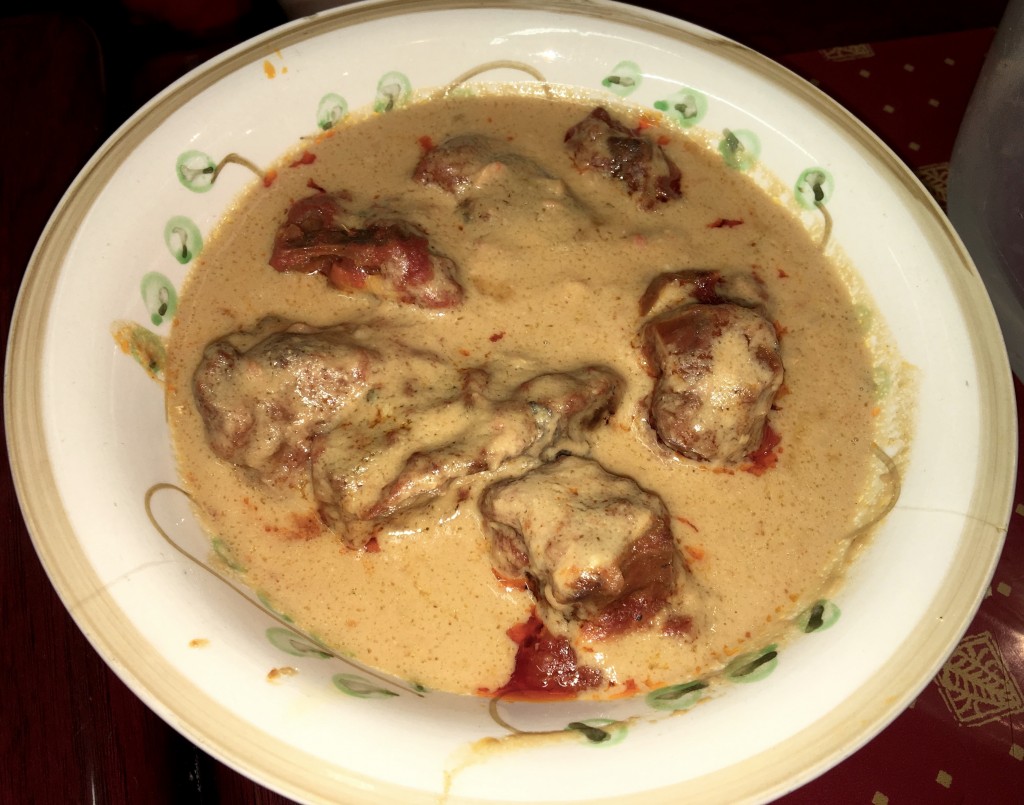 and so is some nice goat

Bognan International Corporation
590 E 169th Street, Bronx
Subway: Freeman Street (2, 5 trains)
|
|
|
You wanna know why I like Germany? Germans have a deep respect for history. In Frankfurt, for example, there are magnificent statues of the city’s greatest historical figures, including this guy:
 immortalized in bronze, just for being really good at eating
More importantly, German pigs seem to be unusually delicious. I’ll be honest: growing up in the Midwest, I frequently ate my face full of bratwurst, which was always good, but never blew me away. But there’s something special about the sausage in Germany. I don’t know what it is: maybe the pigs are tastier because they drink really good beer, or maybe German sausage-making skill was somehow diluted when German immigrants voyaged to the Midwest? I don’t know.
But a few days in Germany reminded me that sausage, done right, is pretty effing great.
 no, pig is not just good — it’s great
On our way to Namibia, we passed through Frankfurt for 24 hours, and later stopped in Munich on our way home. During our Frankfurt layover, the city’s Christmas market was in full swing: basically, the city center turns into a giant, chilly street party, filled with people eating sausage and drinking hot mugs of glühwein, a potent mulled wine seasoned with clove, cinnamon, orange zest, and sugar.
 drink enough glühwein, and this will start to make sense
Interestingly, a few of the glühwein sellers also offered hot caipirinhas. In case you’ve never had a caipirinha: it’s a Brazilian treat made from pounded limes, sugar, and a sugar-cane liquor called cachaça. Brazilians who love drinking caipirinhas on the beach would probably roll over in their graves if they saw a hot version – even if they’re not dead yet. But the hot caipirinhas were actually really appealing, sort of like a nice, citrusy tea – if tea could install an epic hangover.
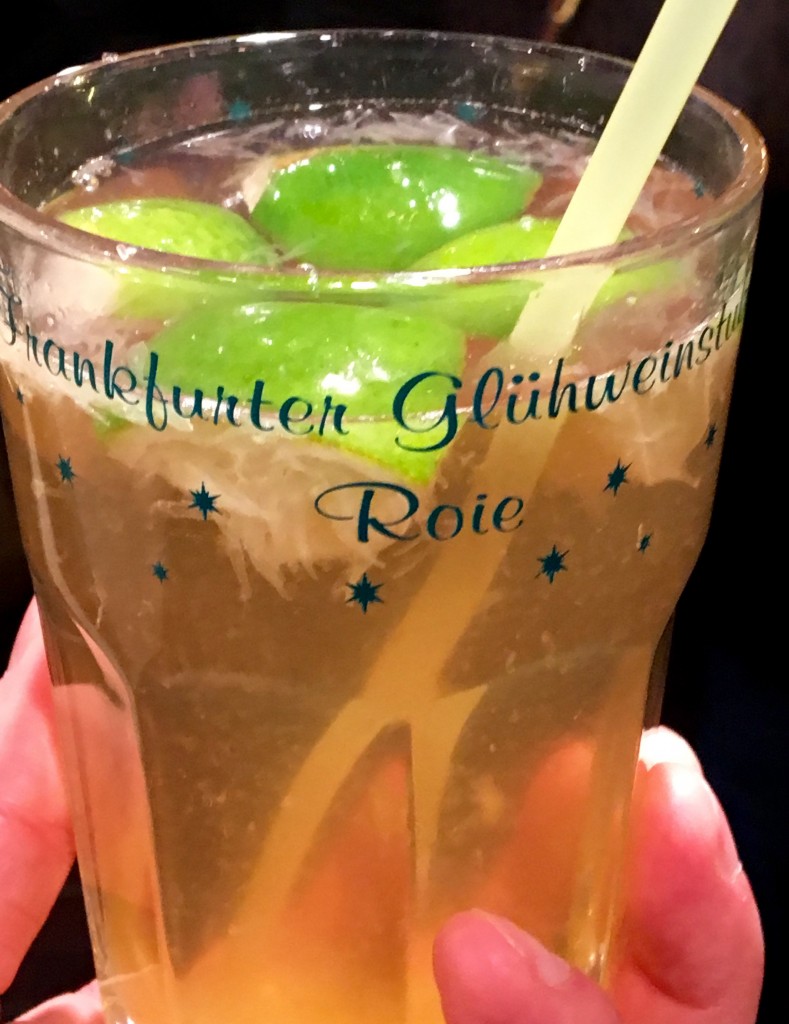 “tea”
But the best part of our (overly brief) time in Germany, other than our phenomenally lovable friend in Munich? Pig. I still can’t quite explain what made the bratwurst better than the stuff I grew up with in the Midwest. The flavors were subtler, somehow, and the fire-grilled meat was served on freshly baked rolls, instead of often-vapid American hot dog buns. (German baked goods, incidentally, are universally incredible, but rarely seem to receive much attention internationally. I don’t get it.) In Munich, I fell in love with onion- and parsley-flecked weisswurst (literally, “white sausage”); my lovely wife couldn’t stop eating currywurst, made from slices of grilled bratwurst, topped with ketchup and curry powder – which is much, much tastier than it may sound if you’re not a sausage or ketchup fan.
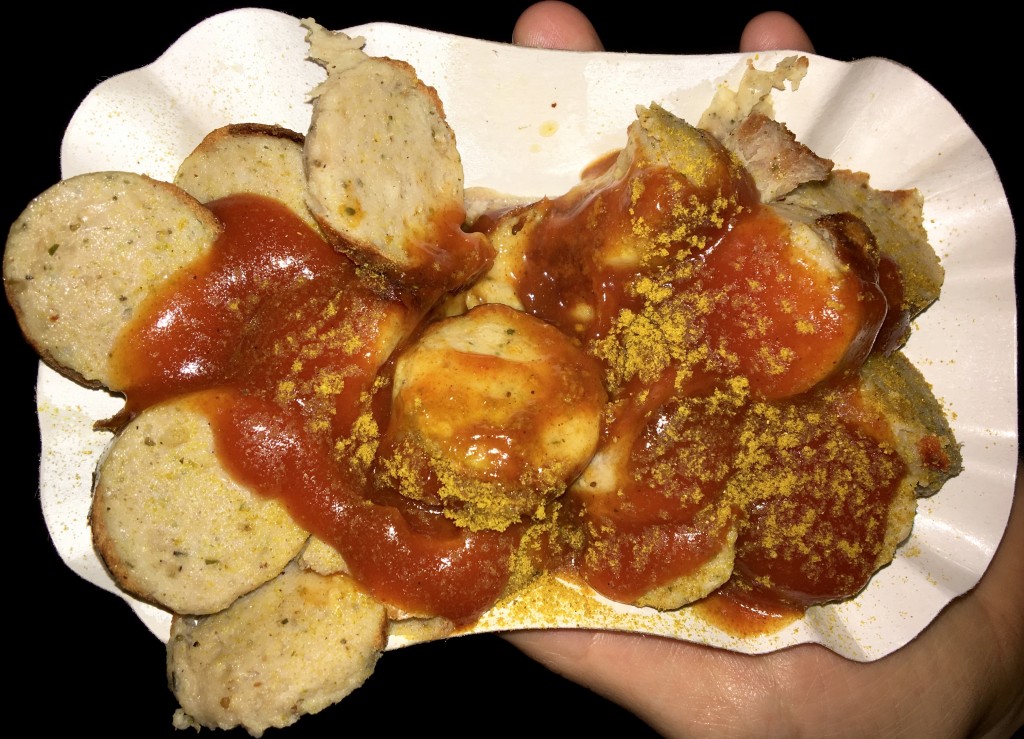 currywurst
Since fire, pig, and Germans are clearly a winning combination, I immediately started searching for great German food when I returned to New York. I’ve had a fair amount of decent German food here. But after eating such wonderful pig in Germany, I figured that there had to be something even better somewhere in the city.
So I finally made the trek out to Zum Stammtisch, a much-beloved Bavarian restaurant in Glendale, Queens, just to see if the pig magic survived the trip across the Atlantic. For the most part, it did. But just because I used to be terrified of herring and feel obligated to continually practice my herring-eating skills, we didn’t start with pig, and instead started with a Bavarian herring salad, featuring beets, potatoes, pickles, tomatoes, and boiled eggs. It was not terrifying.
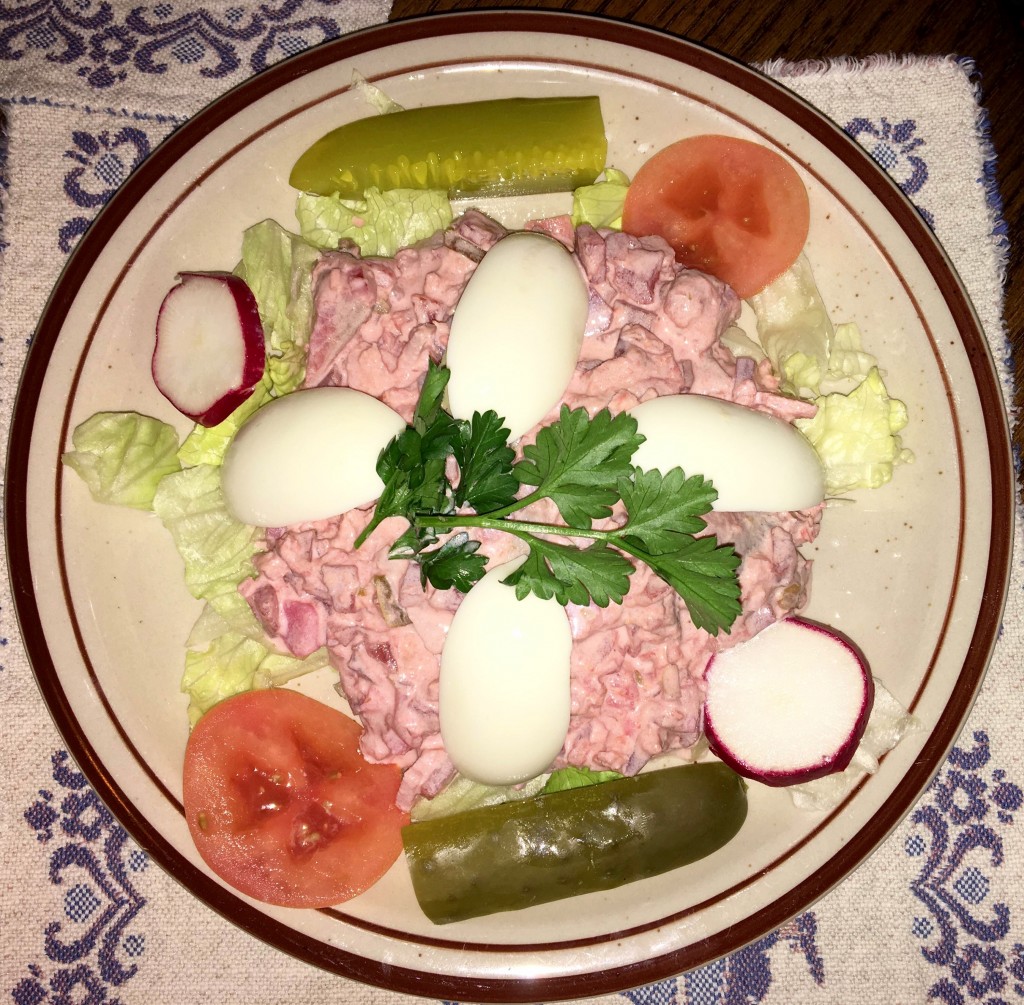
For his main course, my dining companion, a charming documentary filmmaker of German descent who never eats German food, opted for bratwurst and knockwurst (a smoked pork sausage), served atop an epic mount of gently vinegar-y German potato salad and sauerkraut. And yup, both sausages tasted much like the lovely stuff we ate in Germany, other than the fact that it was missing the fire-induced char we enjoyed at the outdoor festivals. But the German sausage-making magic was intact.
Of course, I had to order something that sounded awful, figuring that it would be delicious, interesting, or both. I chose leberkäse – which our dirndl-clad (non-German) waitress described as “German bologna” – but only because it was topped with a fried egg and anchovies. Eggs and anchovies?! On “German bologna”? Sign me up.
To be fair, leberkäse does indeed resemble bologna, but it’s a relatively classy bologna, served at Zum Stammtisch as a lightly-charred steak that must have weighed at least a pound. And a fried egg always makes sense as a condiment. But an anchovy…?!
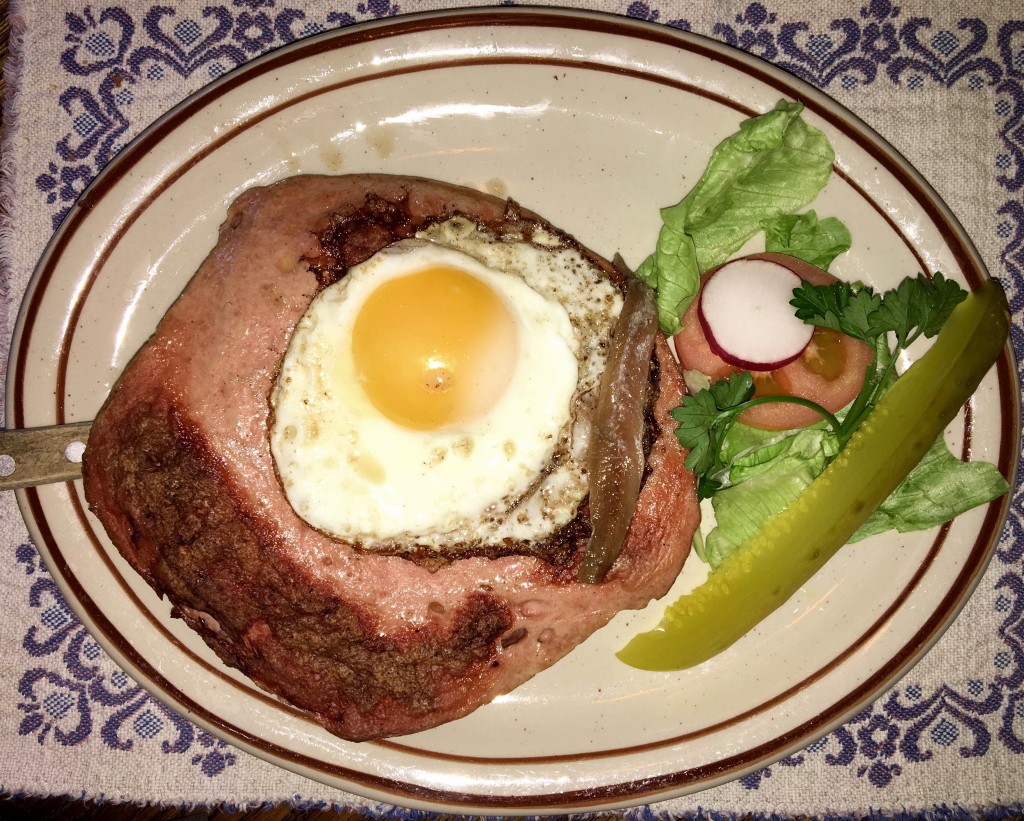 yes… an anchovy
It was actually delicious. I’m not joking. I didn’t know that leberkäse needed a nice strip of intensely salty preserved fish to bring out the best of its porky flavor, but apparently it does. I never thought I’d say this, but I totally wanted more anchovy with my German bologna.
And in case you’re wondering how leberkäse and other delicious German pork products are made, our friends in Frankfurt produced this how-to illustration in pink marzipan:
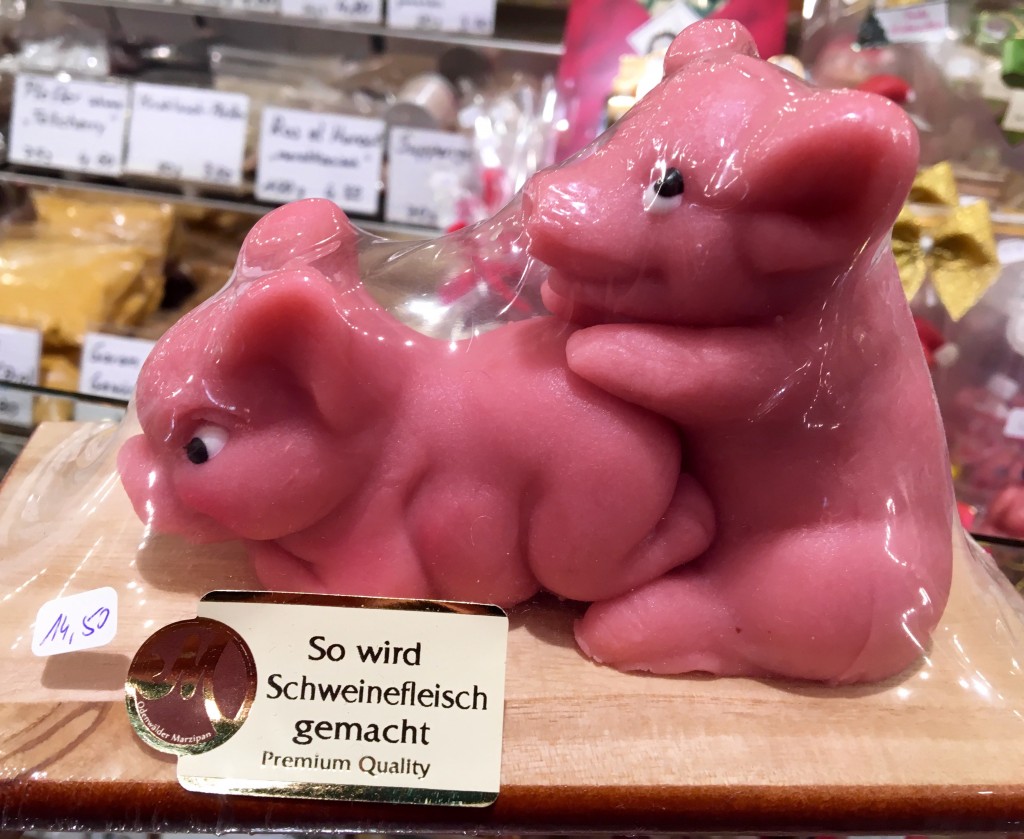

Zum Stammtisch
69-46 Myrtle Avenue, Glendale, Queens
Subway: Fresh Pond Road (M train)
|
|
|
As nearly any transatlantic traveler knows, Icelandair is kind of awesome. The fares are cheap, and you can arrange a stopover in beachy Iceland for no additional charge. Plus, Icelandair’s seat-back screens show awesome things, like images of Yule cats, humongous beasts who eat misbehaving Icelanders before Christmas:
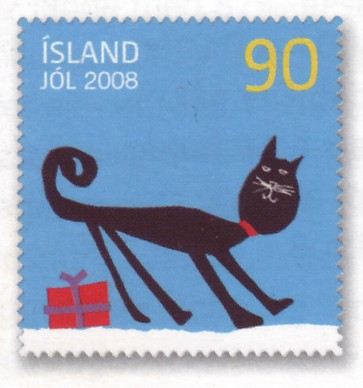 somehow, the version on Icelandic stamps looks friendlier
On our way home from Namibia and Germany, we stopped in Iceland for a day or two, since, you know, Iceland is somewhere between Namibia and the United States. While in Iceland, I ate a whale again. Not the whole thing. Just a few pieces. And now I’m in trouble with an environmental attorney again.
Iceland is one of a small handful of countries that allows commercial whaling, and it is not unusual for whale to appear on menus throughout the country, though I’m told that tourists eat it more frequently than locals do. On a visit to Reykjavik’s Islenski Barinn (“Icelandic Bar”), we started with an appetizer of minke whale – but only because the kitchen had run out of puffin that evening.
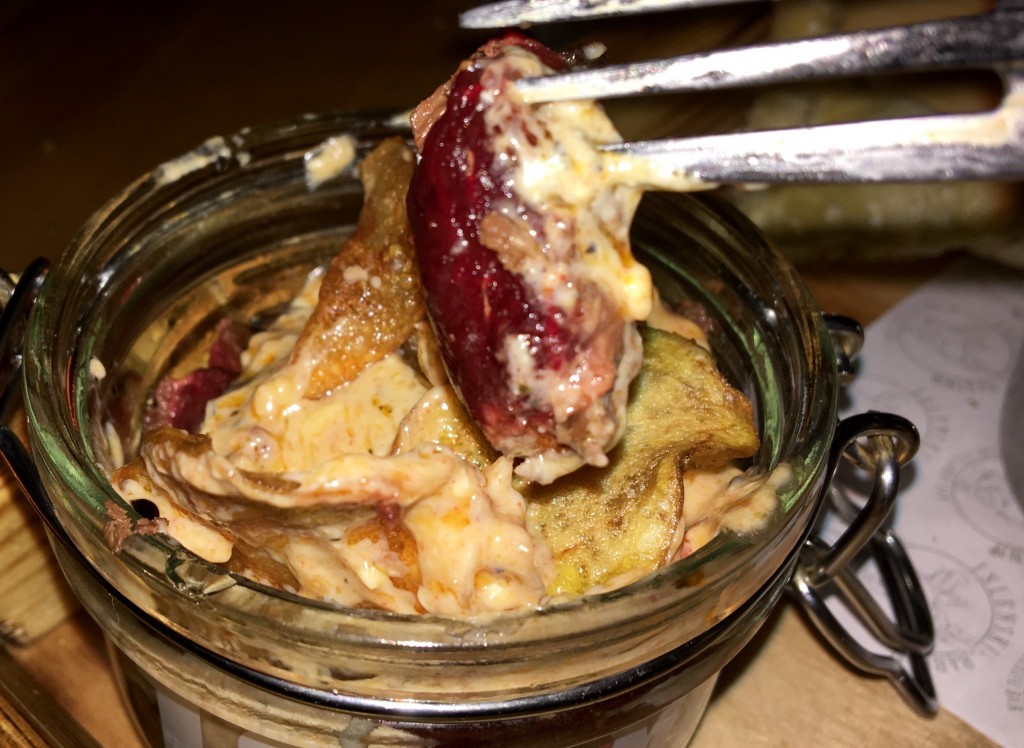 cue the hate mail
The minke whale (not endangered) was served in chilled, bite-sized pieces, closely resembling chunks of ruby-hued, barely-seared ahi tuna steak. It was delicious – perhaps a little bit meatier than sushi-grade tuna, but otherwise similar in flavor. The whale was served with a light cheese sauce – which reminded me of an unusually classy thousand island dressing – and fresh potato chips.
I would tell you that my wife loved it too, but she’s an environmental attorney, and has already filed a lawsuit against me for what I did to that dolphin at the Saint Lucia creole festival last fall.
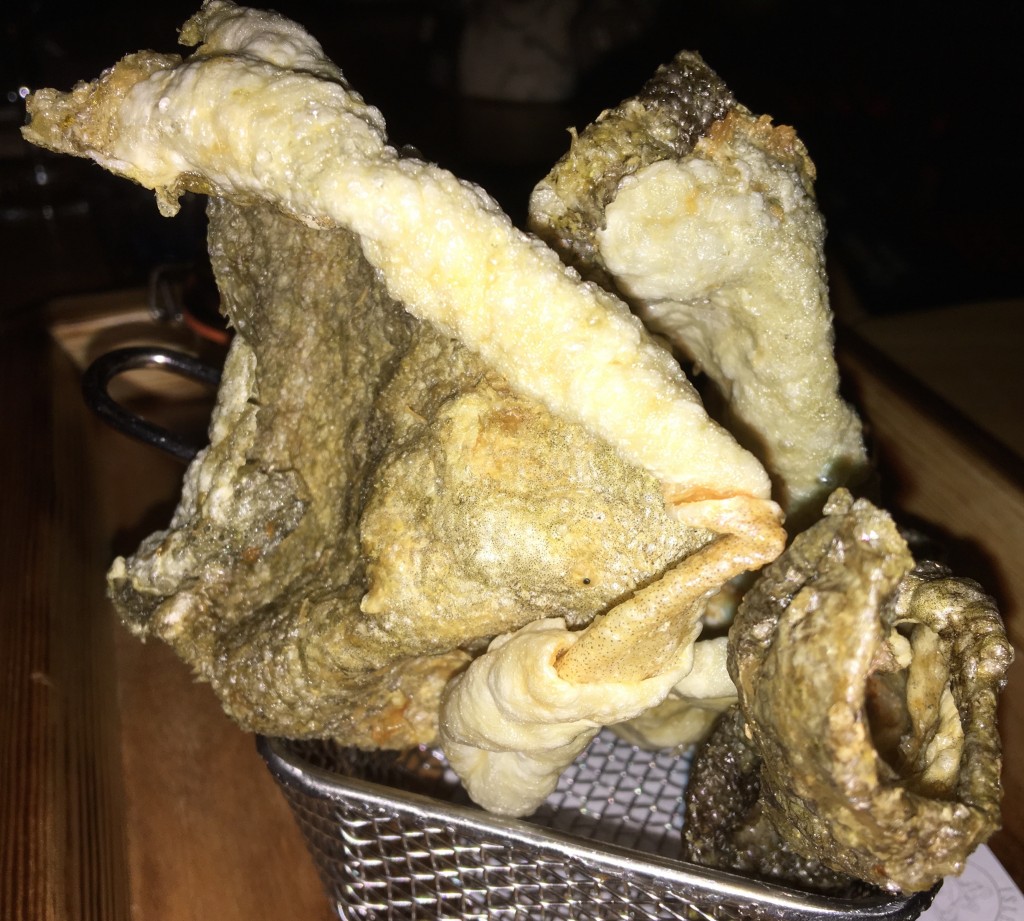 puffed cod skin — not puffin
There’s no shortage of other interesting food options in Reykjavik, though we barely scratched the surface in our overly-quick layover. As an appetizer at Islenski Barinn, we sampled crispy puffed cod skin, which reminded me of an unusually high-quality prawn cracker. We ate plenty of excellent Icelandic seafood, including a spectacular fish bisque and some nice chunks of fresh ling, a tasty, cod-like beast. Unfortunately, we weren’t drunk enough to try the hakarl (putrefied shark), which apparently has exited the mainstream Icelandic diet, and is now mostly a curiosity sold to foreign tourists.
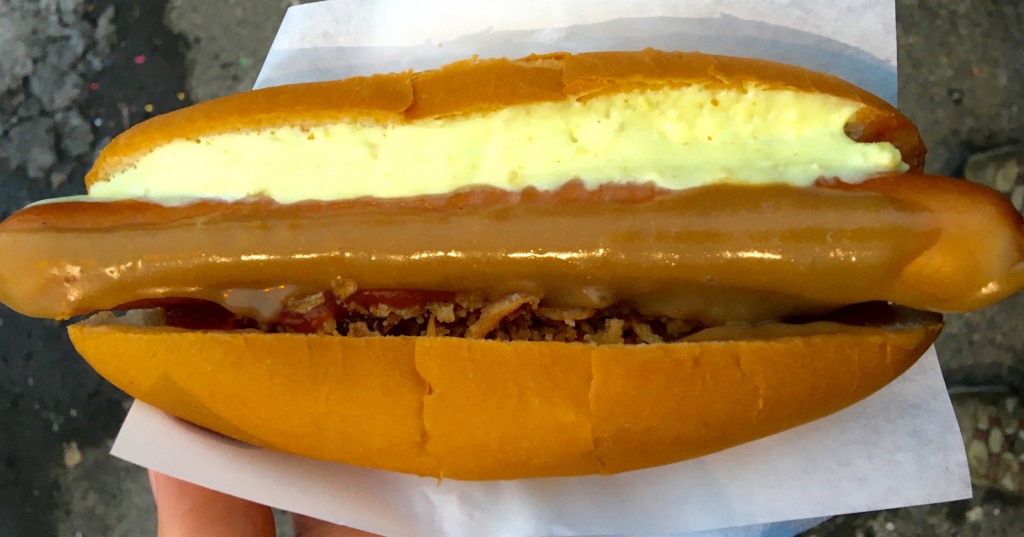 curiously legendary
We did, however, sample the legendary Icelandic hot dogs at Baejarins Beztu Pylsur (literally, “best hot dog in town”), which has repeatedly been lauded as one of the world’s best hot dog stands by international media outlets, including The Guardian, Forbes, and the Huffington Post. Icelandic hot dogs are generally made from locally raised lamb, mixed with bits of beef and pork – and that’s cool, since lamb is pretty tasty. The version at Baejarins Beztu Pylsur is served with a sweet brown mustard, a mayonnaise-and-relish remoulade, fried onions, and raw onions. It’s delicious. I don’t see why it’s such a big deal. It’s a nice hot dog. That’s it.
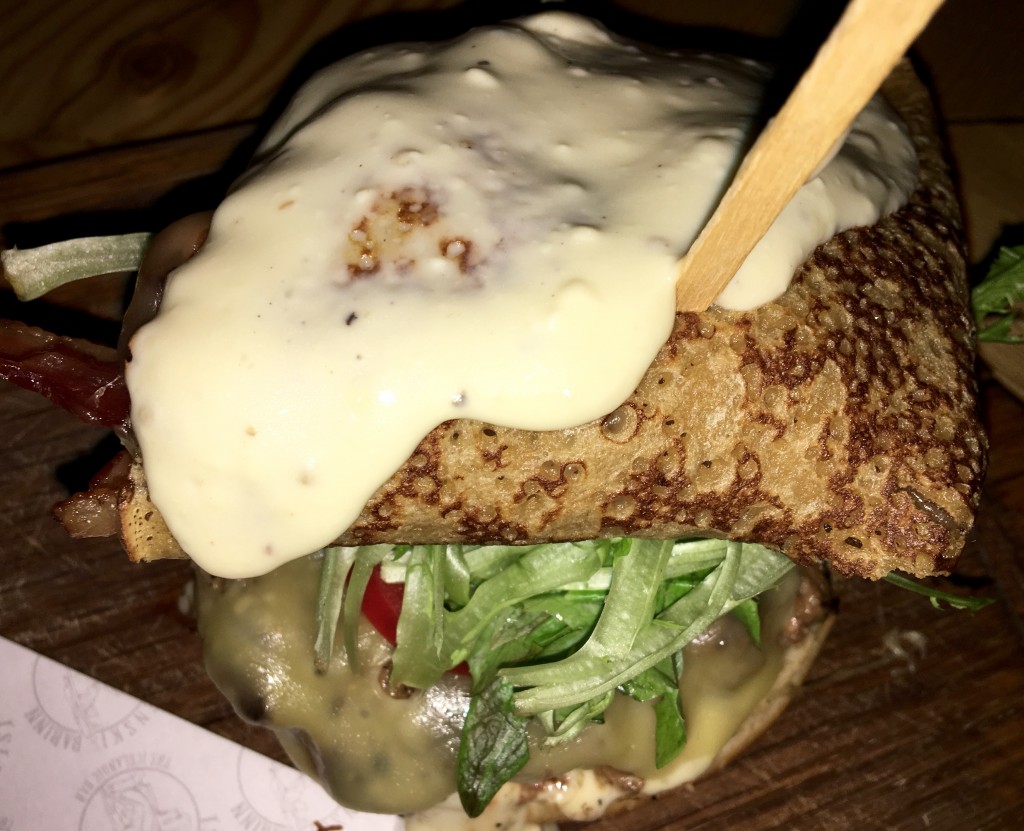 Icelandic triple-gouda, double-bacon pancake burger
Back at Islenski Barinn, we ate a hamburger that was far more interesting: beef topped with bacon, gouda, and a bacon-and-gouda-stuffed Icelandic pancake (similar to a crepe, but a bit denser), which was then topped with a pepper cheese sauce, which was also made from gouda cheese. A burger topped with a pancake, two doses of bacon, and three versions of gouda cheese? Now we’re talking!
And whale? I hate to admit it, but I really liked it yet again. And just because I wrote that, I might be sleeping on the couch again tonight.
 even the geysers are excited about bacon, gouda, and whale
|
|
|
In New York, I often spend hours and hours searching for cuisine from underappreciated African nations, like Namibia. But if I actually go to Namibia, it should be relatively easy to find authentic Namibian food. Right?
Well, maybe not. My lovely wife and I just spent two and a half weeks driving around Namibia, admiring wildlife, gazing at mind-blowingly beautiful scenery, meeting phenomenally friendly Namibians… and feeling vaguely confused about what, exactly, Namibian food is.
Let’s start with the fun and non-confusing stuff, like desert elephants:
 taken with a cell phone camera, not zoomed in — they’re just large
And hauntingly beautiful desert landscapes, often featuring plenty of sand:

And the little-known Namibian tradition of putting bottle caps on your nose when drinking Kuemmerling, a German after-dinner liqueur beloved by our wonderful Namibian hosts in Lüderitz:
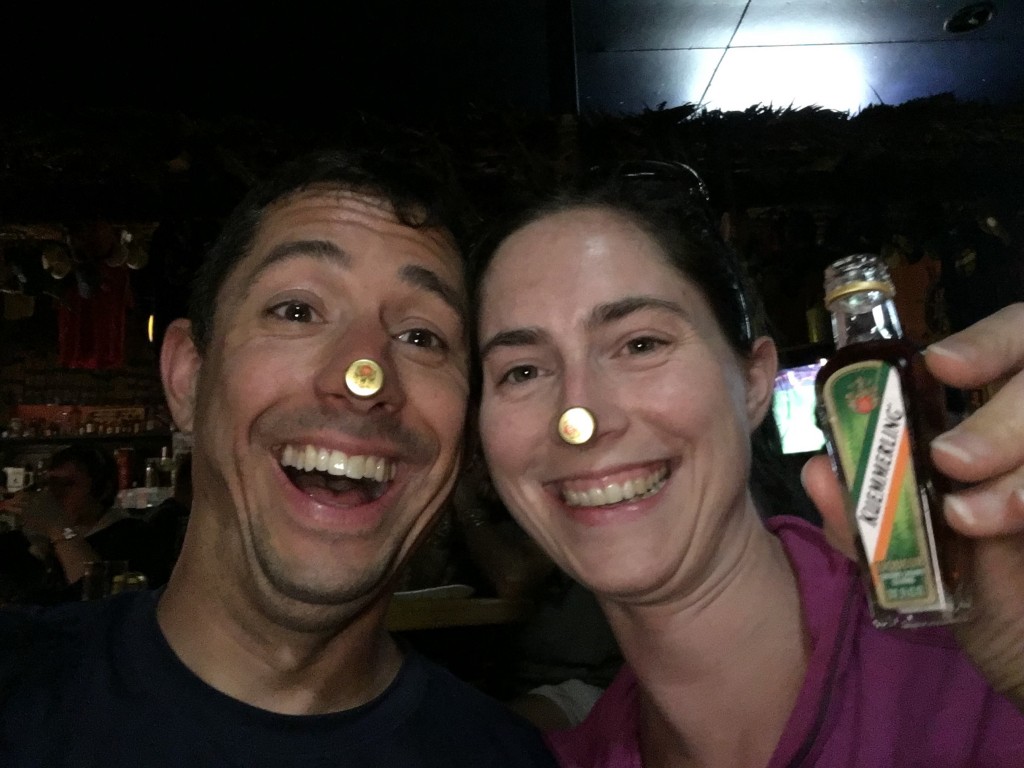 well, at least they told us that it was a Namibian tradition…
If you like wildlife, you’d absolutely love Namibia – whether you enjoy gazing at wildlife, or eating it. Everywhere we went in Namibia, we ate delicious game meat, including this excellent charcuterie plate from the amazing Tandala Ridge B&B near Etosha National Park, featuring smoked kudu, mountain zebra salami, and sliced, chilled zebra steak:
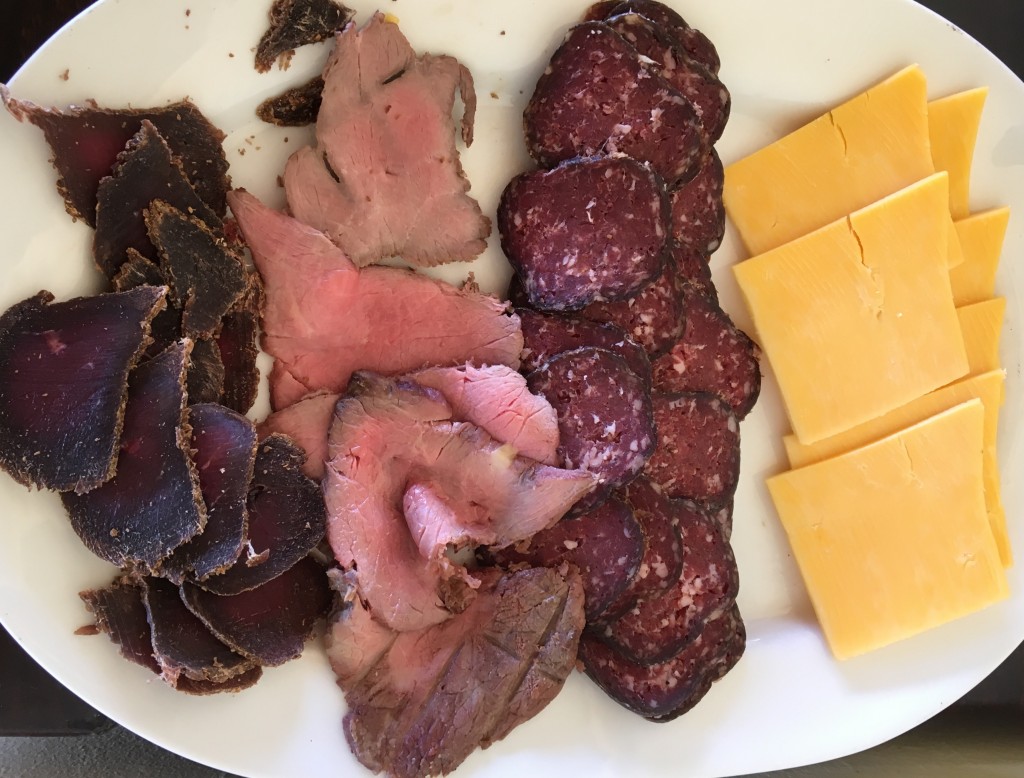
Here’s a nice warthog steak, served with fire-roasted sweet potatoes, zebra boerwors, and corn:
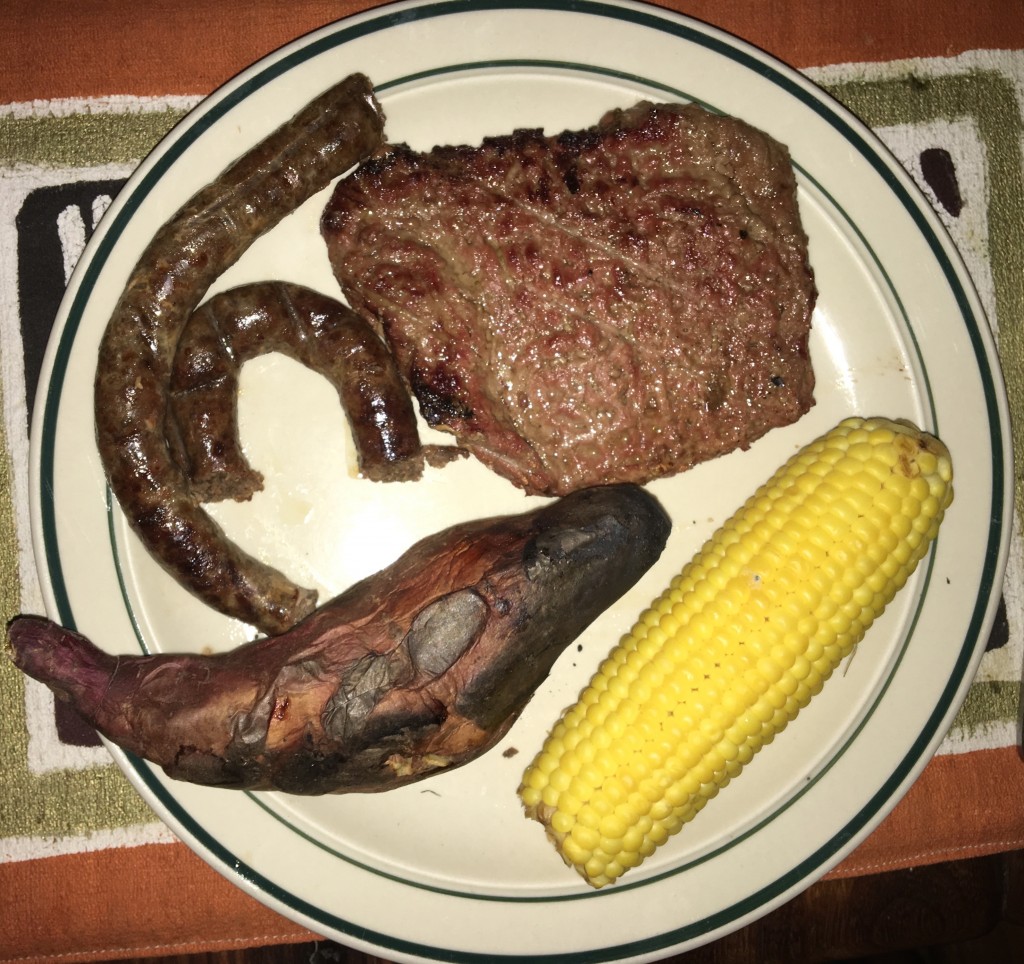 I swear that we didn’t actually eat Pumbaa — just a distant, non-cartoon cousin…?
And here’s a ZLT sandwich:
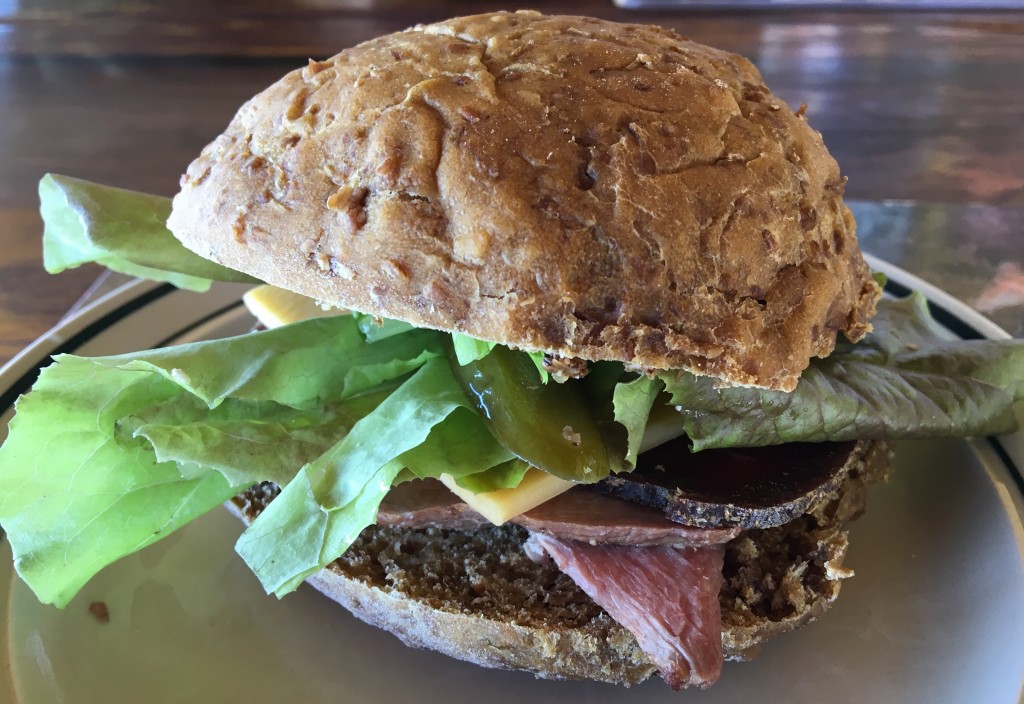 ZLT = zebra, lettuce, and tomato, served with cheese and smoked kudu
Even the non-game meat was delicious in Namibia. In two different cities, we ate an irresistible dish called eisbein: smoked pork knuckle, roasted until it’s blissfully crispy, served with potatoes, red cabbage, sauerkraut, and an array of spicy and sweet mustards:
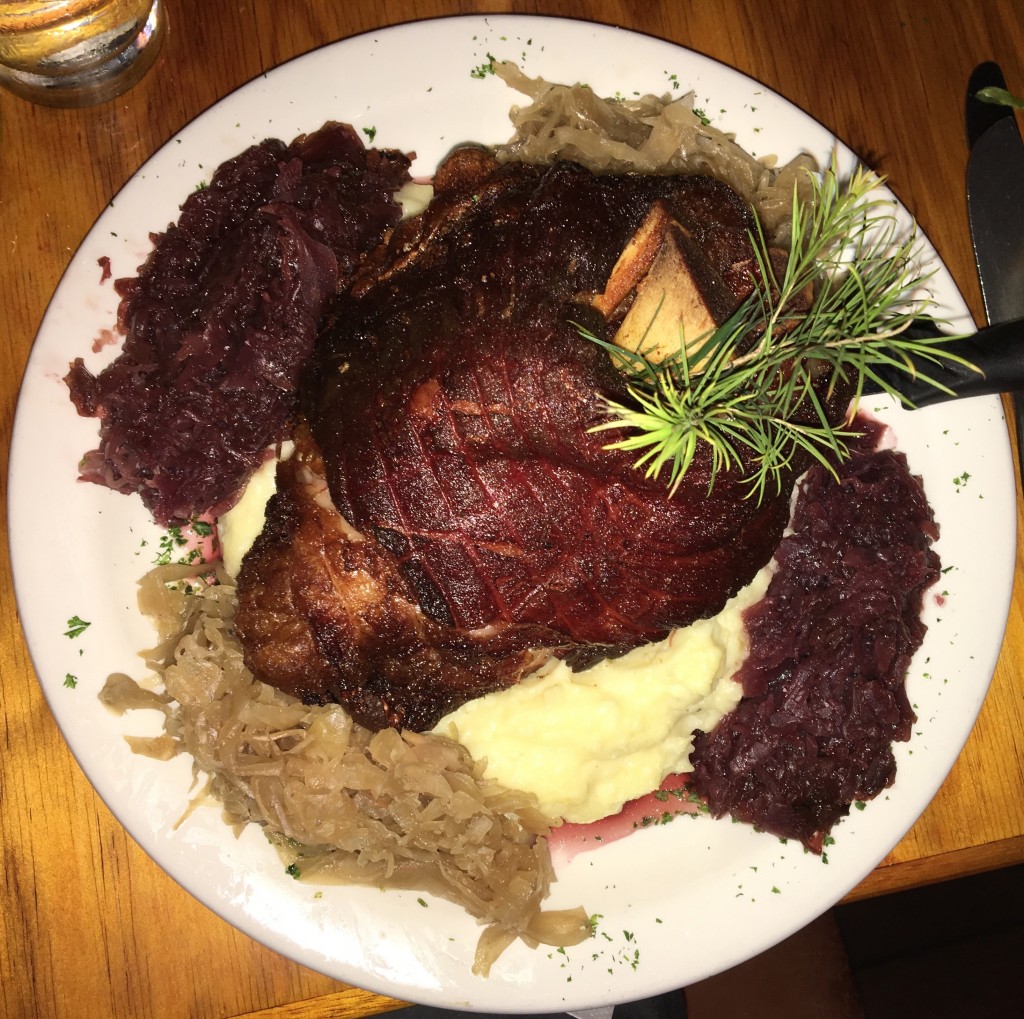
But here’s the thing: I couldn’t shake the feeling that our meals represented only a very limited – and very European – slice of Namibian cuisine. Eisbein, for example, is a German dish (also known as schweinehaxe), though I was told that the crispy skin was “perfected by Namibians”. Our many steak-centric feasts resembled meals that you might eat in an American or German restaurant, accompanied by some combination of potatoes, pasta, and well-behaved vegetables. The only difference is that the beef or lamb had been traded for oryx or zebra — both of which are leaner, more tender, and more flavorful than domesticated meat. That’s perfectly delicious, but were we missing some aspect of Namibian food?
Our meals felt very European, but only around 6% of Namibia’s population is white — mostly descendants of Germans and white South Africans who migrated to Namibia during the colonial period. Namibia is a fascinating ethnic melting pot: despite its incredibly sparse population of 2.2 million people, scattered across an area twice as large as California, Namibia is home to dozens of ethnic groups, including Ovambo, Kavango, Nama, Damara, Herero, Caprivian, and Bushmen, among others. And I couldn’t stop wondering if there were other interpretations of “Namibian cuisine” that might better reflect the traditions of some of Namibia’s non-white population.
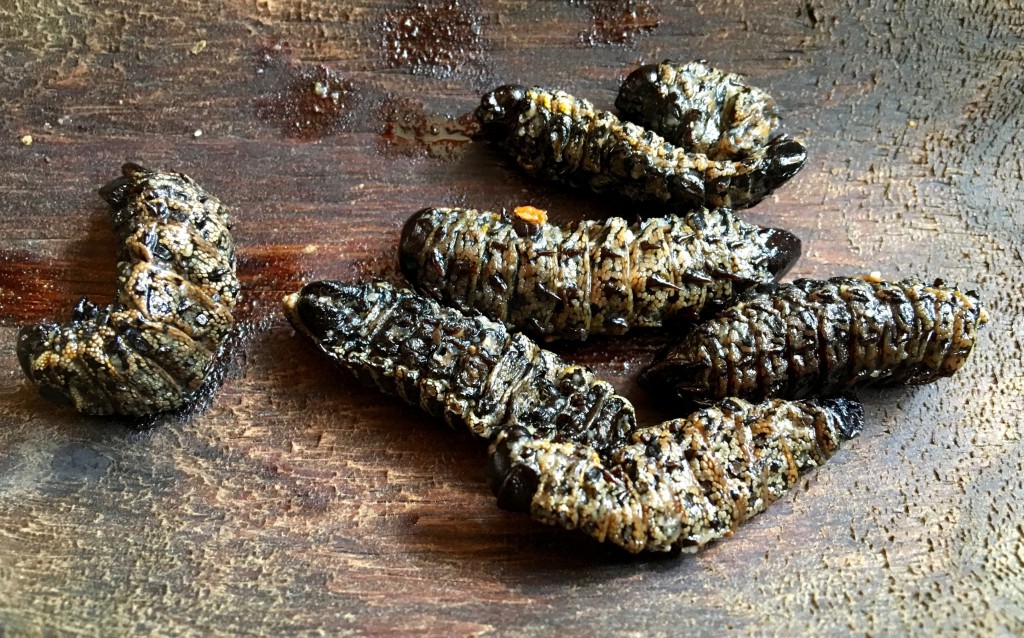 where are you, mopane worms?
So I started asking around. When I asked where I might find Namibian food, one B&B owner in a smaller city just looked confused, and said, “Um, maybe in the capital?” Another acted like I’d farted loudly, and said, “Namibian food? Why would you want to eat that garbage?” I asked for Namibian food at several tourist information centers, and was greeted with shrugs, directions to a grocery store, or the names of (invariably excellent) upscale restaurants that served a familiar array of European-influenced meals.
But I’d read several articles – including this wonderful post by a pair of Peace Corps volunteers – about traditional Namibian treats such as mealie pap (white cornmeal, similar to glorious Malawian nsima), mahangu pap (millet porridge), mopane worms (a protein-rich caterpillar), and fat cakes, among other things. None of these appeared on restaurant menus in the cities, towns, and lodges we visited outside of the capital, Windhoek.
On our final day in the country, we passed through Windhoek on our way back to the airport. This time, I was ready: I’d combed through all 93 restaurants listed on TripAdvisor in Windhoek. Sadly, only 13 claimed to serve any sort of African food at all. And of those, only one – Xwama Cultural Village, tucked away in a non-touristy suburb – had a menu that went beyond the game-focused dishes we’d enjoyed elsewhere in the country.

The Xwama Cultural Village complex includes a B&B, a full-service restaurant, a take-out food stand, a bar, and a craft shop; the place is incredibly charming, built from stone, reeds, wooden logs, and a thatched roof. I was just a tourist, so I obviously don’t know enough to say whether it truly captured the essence of Namibian homes or community spaces, but the entire complex felt genuine and homey, and not like a tourist trap at all.
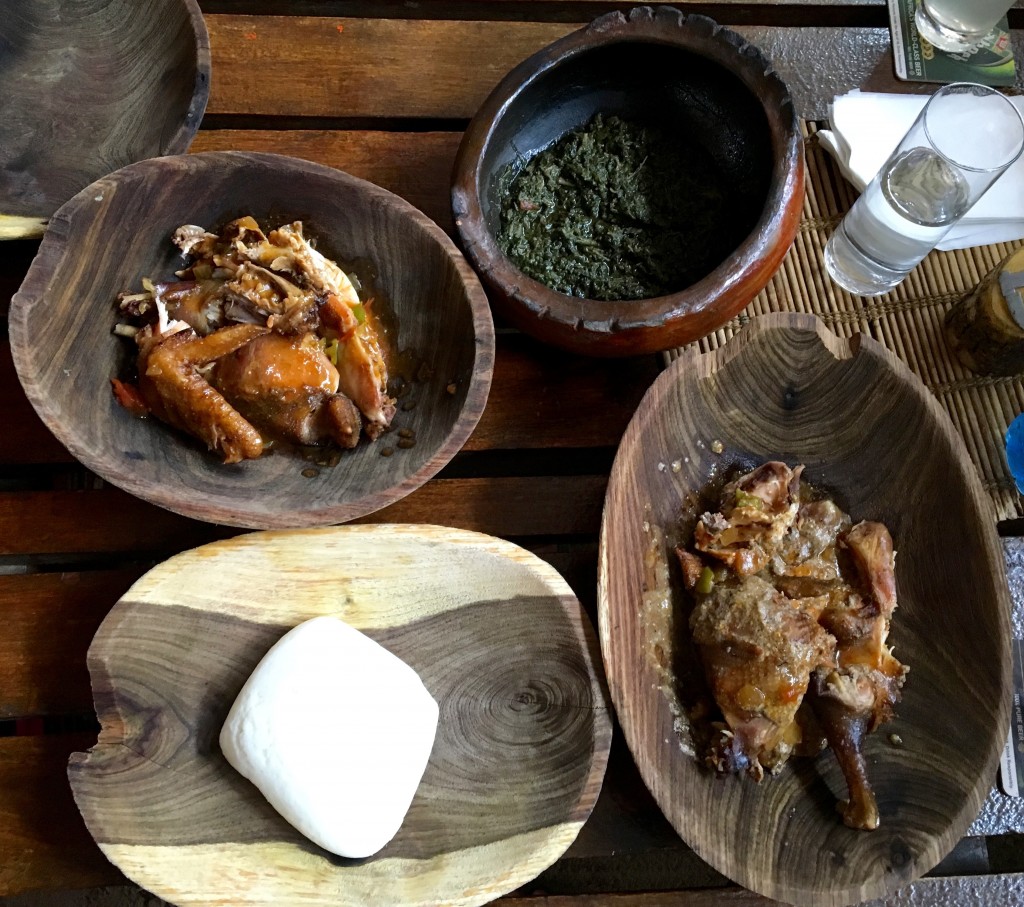 but if tourist traps make food this good, I’m happy to be trapped anytime
The restaurant doesn’t offer forks or any other utensils: you eat your meals from hand-carved communal bowls, with your hands. Before the meal, our wonderfully charming and knowledgeable server, a gentleman named Uahimisa (also known as Costa), brought a basin and warm water to our table so we could wash our hands. Once we were cleaned up, we asked Uahimisa about the mopane worms, which are served only in 250-gram (roughly half-pound) portions, and he graciously brought a sample out for us, just to make sure that we actually liked them before we committed to eating a mountain of them.
Mopane worms are actually a type of caterpillar; the guts are squeezed out, the worms are dried in the sun, and then they’re seasoned and pan-fried. They aren’t necessarily cute, but they’re delicious: they taste something like a meaty portobello mushroom, braised in beef broth. If you had blindfolded me and told me that I was eating the pan-fried love child of a mushroom and a cow, I might have believed you. To be honest, we thought that they were too rich to eat as a main course, as much as we loved them.
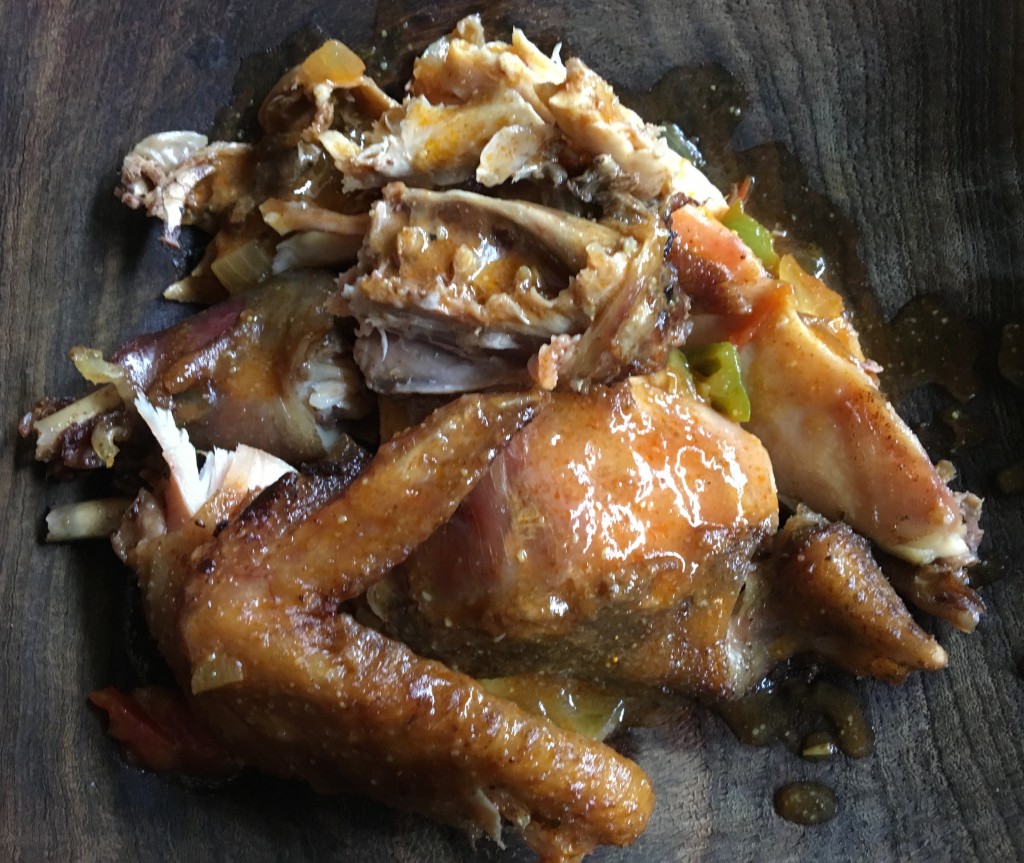 traditional marathon chicken
After snacking on a few mopane worms, we moved on to our four-headed main course. We opted for marathon chicken (variously known as Owambo chicken, Wambo chicken, or roadrunner chicken), slow-cooked in tomato, onion, peppers, and (I think) marula nut oil; it was one of those fowl-from-the-heavens experiences, with the meat falling off the bone and into a perfectly seasoned gravy.
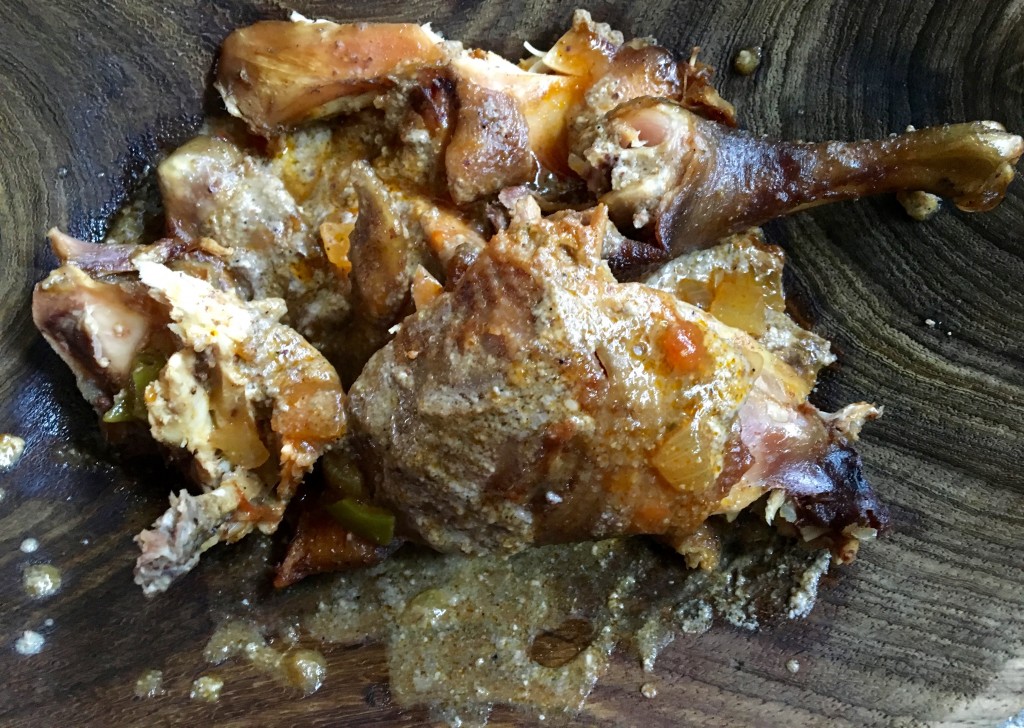 this time, with marula nuts
Another variation on marathon chicken was equally appealing, in a marula nut sauce that reminded us of a refined version of groundnut stew. And my personal favorite was the wild spinach (omboga), stewed in something magical that I couldn’t quite place. And just as we were taught to do by our favorite Malawian chef, we scooped everything with mealie pap (white cornmeal), which I still love dearly.
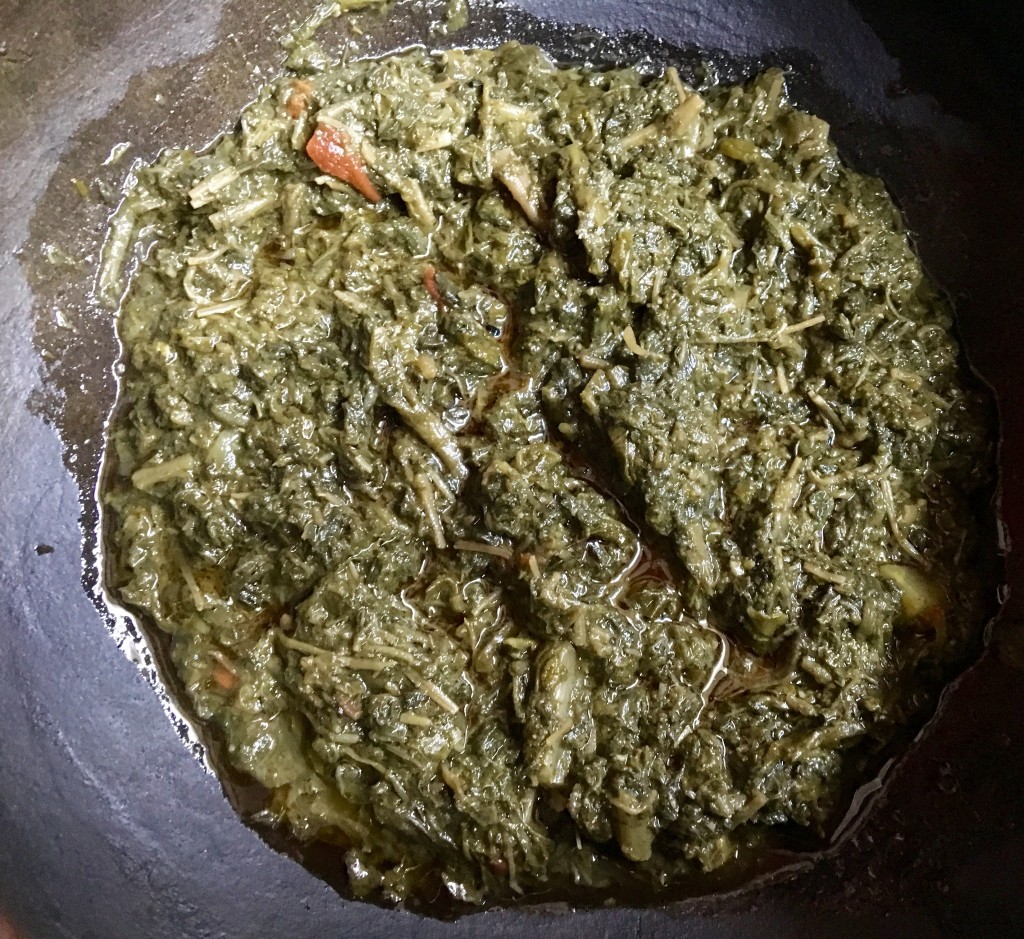 eat your (wild) spinach, tourists
We certainly had eaten well during our weeks in Namibia, but the meal at Xwama was easily our favorite. Which makes me wonder: why is it so difficult for tourists to find this cuisine elsewhere in the country? We visited several of the nation’s tourist hot spots outside of Windhoek, and looked – hard – for interesting food. Maybe we were just unlucky, maybe we looked in the wrong places, or maybe we were simply in the wrong parts of the country, somehow. But such delicious traditional food should be everywhere, in plain sight, alongside the other cuisines we enjoyed in Namibia. I’m sure that we aren’t the only foreign tourists who would LOVE to taste a full variety of Namibian foods, not just game steaks and fried fish.
So I’m begging you, Namibia: make tourists eat this stuff. Feed us wild spinach and fat cakes and Mopani worms and millet beer and mealie pap and grilled oryx and grilled donkey and eisbein. Maybe it’s true that only oddball tourists will actually go out of their way to find a place like Xwama. But if you stick great Namibian food in our faces at all of the major tourist destinations, I’ll bet that plenty of tourists would learn to love it.
Now could somebody please clone the Xwama Cultural Village in Walvis Bay, Sesriem, Lüderitz, Okaukuejo, and New York City? Especially New York City? I’m ready for more of that wild spinach.
Like some Namibian tourist resorts, New York City has a lamentable shortage of delicious Namibian food. If you happen to know anybody from Namibia or nearby countries (Botswana, Zambia, Zimbabwe) who might be willing to speak with me, please email me at [email protected] or send me a message via Twitter or Facebook.
|
|
View My Favs!
Search This Blog
Food By Region
|











































